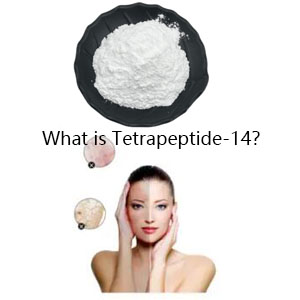What is Tetrapeptide-14?

Tetrapeptide-14 is a synthetic peptide making waves in the skincare industry for its ability to soothe inflammation and reduce redness. Composed of four amino acids, it targets specific skin concerns like rosacea and sensitivity, offering B2B cosmetic manufacturers a powerful ingredient to enhance product efficacy. This article dives into its science, benefits, and applications, providing actionable insights for industry professionals.
What Makes Tetrapeptide-14 Unique
Tetrapeptide-14, developed by Helix Biomedix, is a bioactive peptide designed to calm irritated skin and even out complexion. Its unique sequence of amino acids—proline, glutamic acid, lysine, and others—enables it to interact with skin cells to reduce inflammation and promote a healthier skin barrier.
Chemical Structure and Synthesis
This peptide is synthesized through precise biotechnological methods, ensuring high purity (often ≥95%) and stability. Its small molecular size allows it to penetrate the skin effectively, targeting inflammation at the cellular level. Suppliers like Ataman Kimya emphasize its low toxicity, with minimal risks for cancer, allergies, or reproductive harm, making it safe for cosmetic use.
Mechanism of Action
Tetrapeptide-14 works by down-regulating interleukin-6 (IL-6), a pro-inflammatory molecule that triggers redness and irritation. By inhibiting IL-6, it reduces matrix metalloproteinase-1 (MMP-1) activity, which degrades collagen and contributes to skin aging. This dual action soothes skin while supporting structural integrity, as noted in studies by Cosmetics & Toiletries.
Key Benefits for Skincare
Tetrapeptide-14 offers a range of benefits that make it a standout ingredient for anti-aging and sensitive skin formulations, addressing consumer demand for gentle yet effective products.
Reduces Redness and Inflammation
Clinical trials show that a 5% concentration of Tetrapeptide-14, combined with botanicals like green tea and boswellia serrata, can reduce rosacea-related redness by up to 50% in four weeks. Its soothing properties make it ideal for sensitive skin types prone to irritation.
Improves Skin Tone and Brightness
By minimizing post-inflammatory hyperpigmentation, Tetrapeptide-14 helps achieve a more even complexion. Its ability to calm skin and reduce discoloration appeals to consumers seeking radiant, uniform skin tone, as highlighted in products like Solvasa DeStressance Serum.
Supports Skin Barrier Health
The peptide strengthens the skin’s natural barrier by promoting protein synthesis and hydration. This enhances resilience against environmental stressors, making it a valuable addition to moisturizers and serums for daily use.
Applications in Cosmetic Formulations
Tetrapeptide-14’s versatility allows it to shine in various skincare products, from daily moisturizers to specialized treatments, offering B2B clients flexibility in product development.
Moisturizers and Serums
At concentrations of 1–5%, Tetrapeptide-14 is ideal for leave-on products like moisturizers and serums. Its synergy with ingredients like niacinamide and antioxidants enhances efficacy, as seen in products like JLo Beauty That Blockbuster Wonder Cream. Formulators can create lightweight, non-irritating formulas for daily use.
Treatments for Sensitive Skin
The peptide’s anti-inflammatory properties make it perfect for products targeting rosacea or post-sun exposure redness. Brands like AlumierMD and Kate Somerville incorporate it into calming creams and serums, addressing niche markets with sensitive skin concerns.
Combination with Botanicals
Tetrapeptide-14 is often paired with natural extracts like honey and rooibos, as in Granactive AR-1423, to amplify its soothing effects. This combination allows brands to market products as both science-backed and naturally derived, appealing to eco-conscious consumers.
Formulation and Stability Guidelines
To ensure Tetrapeptide-14 performs optimally, manufacturers must adhere to specific guidelines for formulation, storage, and compatibility to maintain its stability and efficacy.
Optimal Concentrations
Studies recommend using Tetrapeptide-14 at 1–5% for maximum effectiveness without increasing costs unnecessarily. Higher concentrations may not yield proportional benefits. It pairs well with hydrating agents but should avoid alpha hydroxy acids (AHAs), which may reduce its efficacy.
Storage Requirements
To maintain stability, store Tetrapeptide-14 at 2–8°C in a cool, dry environment away from light. For long-term storage, -20°C is ideal. Airtight packaging prevents degradation, ensuring consistent performance in final formulations.
Compatibility Considerations
The peptide is compatible with most cosmetic bases, including emulsions and gels, but formulators should avoid combining it with strong oxidizing agents or acidic ingredients that could destabilize it. Pre-formulation testing is critical to ensure synergy with other actives.
Market Potential and Opportunities
The growing demand for peptide-based skincare positions Tetrapeptide-14 as a high-value ingredient for B2B companies looking to differentiate their offerings in a competitive market.
Rising Consumer Interest
Market data shows a 7.8% annual growth in peptide-based cosmetics, driven by consumer preference for science-backed ingredients. Tetrapeptide-14’s proven efficacy in reducing redness and improving skin health aligns with this trend, offering brands a competitive edge.
Targeting Niche Markets
The peptide’s ability to address specific concerns like rosacea and sensitive skin makes it ideal for niche products. B2B suppliers can target dermatologist-recommended brands or clean beauty lines, capitalizing on the demand for targeted solutions.
Innovation and Branding
Companies can leverage Tetrapeptide-14’s bioactive properties to create premium products with claims like “clinically proven redness reduction.” Partnerships with suppliers offering high-purity peptides and technical support can enhance product credibility and marketability.
Tetrapeptide-14 is a game-changer for the skincare industry, offering a scientifically validated solution for redness, inflammation, and uneven skin tone. Its versatility, safety, and compatibility make it a must-have for B2B cosmetic manufacturers aiming to meet consumer demand for effective, gentle products. By incorporating this peptide into innovative formulations, brands can deliver visible results and build trust in a competitive market.


